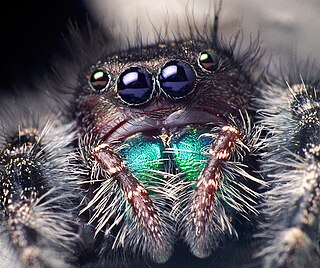
Phidippus is a genus in the family Salticidae. Some of the largest jumping spiders inhabit this genus, and many species are characterized by their brilliant, iridescent green chelicerae. Phidippus is distributed almost exclusively in North America, with the exception of two exported species. As of January 2021, there were about 80 described species in the genus. Species previously described in Phidippus which are found in India and Bangladesh do not belong in this genus.

Phidippus audax is a common jumping spider of North America. It is commonly referred to as the daring jumping spider, or bold jumping spider. The spider belongs to the genus Phidippus, a group of jumping spiders easily identified both by their relatively large size and their iridescent chelicerae.

Phidippus cardinalis is a species of jumping spider. It is commonly called cardinal jumper. It is one of the species of jumping spiders which are mimics of mutillid wasps in the genus Dasymutilla ; several species of these wasps are similar in size and coloration, and possess a very painful sting.
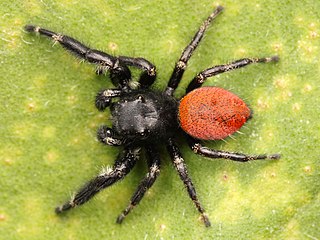
Phidippus johnsoni, the red-backed jumping spider, is one of the largest and most commonly encountered jumping spiders of western North America. It is not to be confused with the unrelated and highly venomous redback spider.

Phidippus californicus is a species of jumping spider. It is found in the southwestern United States and northern Mexico.

Phidippus putnami is a species of jumping spider found in the United States.
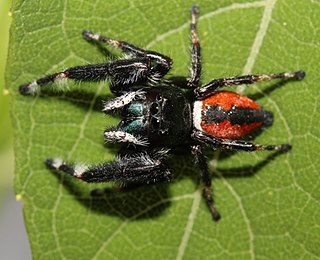
Phidippus clarus is a species of jumping spider found in old fields throughout eastern North America. It often waits upside down near the top of a plant, which may be useful for detecting prey, and then quickly jumps down before the prey can escape. The spider is one of 60 species in the genus Phidippus, and one of about 5,000 in the Salticidae, a family that accounts for about 10% of all spider species. P. clarus is a predator, mostly consuming insects, other spiders, and other terrestrial arthropods.

Habronattus cognatus is a species of spider in the family Salticidae. It is found in North America.
Phidippus bidentatus is a species of jumping spider in the family Salticidae. It is found in a range from the United States to Costa Rica.
Phidippus phoenix is a species of jumping spider in the family Salticidae. It is found in the United States and Mexico.
Phidippus ardens is a species of jumping spider in the family Salticidae. It is found in the United States and Mexico.

Phidippus insignarius is a species of jumping spider in the family Salticidae. It is found in the United States.

Habronattus orbus is a species of jumping spider in the family Salticidae. It is found in the United States.

Habronattus texanus is a species of jumping spider in the family Salticidae. It is found in the United States and Mexico.
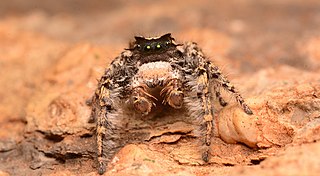
Phidippus carolinensis is a species of jumping spider in the family Salticidae. It is found in the United States and Mexico.

Marpissa formosa is a species of jumping spider in the family Salticidae. It is found in the United States.

Tutelina harti is a species of jumping spider in the family Salticidae. It is found in the United States and Canada.

Talavera minuta is a species of jumping spider in the family Salticidae. It is found in Russia, Canada, and the United States.

Chalcoscirtus diminutus is a species of jumping spider in the family Salticidae. It is found in the United States.
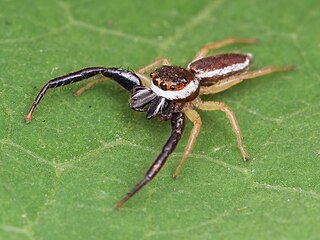
Hentzia palmarum, the common hentz jumper, is a species of jumping spider in the family Salticidae. It is found in North America, Bermuda, The Bahamas, and Cuba.






















